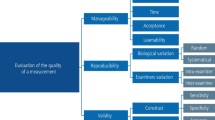Abstract
Data sources
Medline (1999–June 2004) provided the primary data source with references from one paper being reviewed for additional studies. The authors of one article were contacted for additional details.
Study selection
Articles, in English that assessed a commercially available caries detection device the DIAGNOdent (KaVo Dental GmbH Biberach), used human teeth with and without caries, and expressed diagnostic performance in terms of sensitivity and specificity of caries detection against a histological gold standard were included.
Data extraction and synthesis
Data were extracted to determine whether articles included: an appropriate study population; an adequate description of the test; an appropriate reference standard; a blinded comparison of test and reference samples and avoidance of verification bias. No quality score was assigned.
Results
Of the 25 studies identified, 16 assessed the in vitro performance of DIAGNOdent (DD) on occlusal surfaces of primary and permanent posterior teeth, four reported similar in vivo assessments, two examined DD performance on smooth surfaces and the final three addressed detection of secondary caries and residual caries in simulated cavities. DD sensitivity scores for in vitro detection of occlusal dentinal caries ranged from 0.19 to 1.0 (n=16) with 14 of the 16 results being ≥0.73. Specificity values ranged from 0.52 to 1.00. DD tended to show higher sensitivity but lower specificity than visual assessment methods. Only four studies considered DD in vivo performance and demonstrated sensitivity from 0.73 to 0.96 and specificity from 0.63 to 0.95.
Conclusions
In the limited studies available DD demonstrated greater sensitivity but poorer specificity than visual caries diagnosis. Combined with the fact that little in vivo evidence is available for DD performance, the greater number of false-positive diagnoses suggest it should not be relied on as a clinician's primary diagnostic method.
Similar content being viewed by others
Commentary
Two systematic reviews of the literature on various diagnostic techniques1 and specifically the visual/tactile2 method for dental caries detection has shown that there is great variation in study designs, and methods of data collection and presentation. As such a precise estimate of the performance of various diagnostic techniques has not been possible; however, where visual tactile methods were concerned there was general agreement that it resulted in a high specificity (correct identification of sound sites) but low sensitivity (correct identification of carious sites). This means that a dentist is unlikely to record a sound surface as carious from a visual examination, but is likely to miss many lesions, hence the demand for more accurate caries detection devices. The first of these systematic reviews predates the majority of publications on a newly introduced laser fluorescence device, the DD.
This systematic review of the literature on the DD is therefore timely, but only searched one database, namely MEDLINE, other databases such as Pubmed and Embase should have been searched to reduce the likelihood of relevant publications being excluded from the study. In addition, only articles in English were included. A more recent Pubmed search using the key word “DIAGNOdent” and “dental caries” revealed a further three research publications with English abstracts.3, 4, 5 From the English abstracts of these papers it is clear that they would not have met the inclusion criteria for this study. Therefore, the number of papers missed in this publication is likely to be relatively low and the search acceptable to base the conclusions upon.
The results obtained from the included publications mainly pertain to occlusal caries and are clearly presented in three tables. Sensitivity and specificity values for dentine caries detection in vitro are very variable between the studies (0.19–1.00 and 0.52–1.00, respectively). Caries prevalence may have played a role in influencing the outcome in each study and this is presented for most studies. Size of lesions investigated may also impact on the diagnostic accuracy. This is not documented in this review and as such it is important to compare the relative diagnostic accuracy of the DD with currently accepted diagnostic methods, namely visual and radiographic examination. Only 31% of the papers compare DD outcome with visual examination and 19% with visual and radiographic examination.
Information from clinical studies is limited due to the lack of a histological “gold standard” and constrained ethically as surfaces recorded as sound cannot be investigated, hence information on clinical use is limited. It has been shown previously that DD readings taken on moist teeth and dry teeth do not correspond,6 as such the results from the laboratory studies cannot be directly extrapolated to clinical studies.
The results from studies included in this systematic review of the literature are limited and vary greatly. The conclusions made from this well-presented systematic review of the literature are correct and of clinical significance. While a meta-analysis could not be carried out due to the heterogeneity of the studies, the low specificity values recorded are a concern and if used as a primary diagnostic method, the DD could lead to false-positive diagnoses of caries and over treatment.
Practice points
-
Diagnostic devices (eg, DIAGNOdent) that have an increased sensitivity (detection of disease) usually do this at the expense of specificity (correct detection of sound sites).
-
The DIAGNOdent is a typical example and should not be used to make a decision on operative treatment as low specificity means that many sound sites are incorrectly diagnosed as carious. However, they do provide an objective reading which could supplement a clinical and radiographic examination so that it can be used to monitor lesions over time.
References
Bader JD, Shugars DA, Bonito AJ . A systematic review of the performance of methods for identifying carious lesions. J Pub Health Dent 2002; 62:201–213.
Ismail AI . Visual and visuo-tactile detection of dental caries. J Dent Res 2004; 83 Spec No C:C56–C66.
Mendes FM, Pinheiro SL, Bengtson AL . Effect of alteration in organic material of the occlusal caries on DIAGNOdent readings. Pesqui Odontol Bras 2004; 18:141–144 [Epub, 5 Aug 2004].
Naphausen MT, Riemersma M, Verdonschot EH . Diagnosis of occlusal caries lesions using laser fluorescence measurements. Ned Tijdschr Tandheelkd 2002; 109:3–7.
Nemes J, Csillag M, Toth Z, Fazekas A . Reproducibility of the laser fluorescence method for the diagnosis of occlusal caries. Clinical study. Fogorv Sz 2001; 94:33–36.
Lussi A, Imwinkelried S, Pitts N, Longbottom C, Reich E . Performance and reproducibility of a laser fluorescence system for detection of occlusal caries in vitro. Caries Res 1999; 33(4):261–266.
Author information
Authors and Affiliations
Additional information
Address for correspondence; JD Bader, Department of Operative Dentistry, University of North Carolina, CB# 7450, Chapel Hill, NC 27599-7450, USA.
Bader JD, Shugars DA. A systematic review of the performance of a laser fluorescence device for detecting caries. J Am Dent Assoc 2004 Oct; 135(10):1413–1426
Rights and permissions
About this article
Cite this article
Ricketts, D. The eyes have it. Evid Based Dent 6, 64–65 (2005). https://doi.org/10.1038/sj.ebd.6400346
Published:
Issue Date:
DOI: https://doi.org/10.1038/sj.ebd.6400346
This article is cited by
-
Clinical diagnosis of fissure caries with conventional and laser-induced fluorescence techniques
Lasers in Medical Science (2010)



